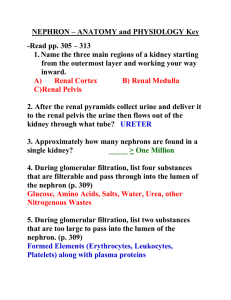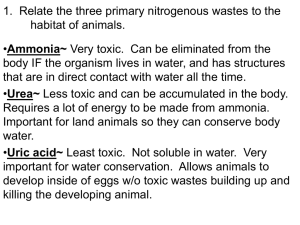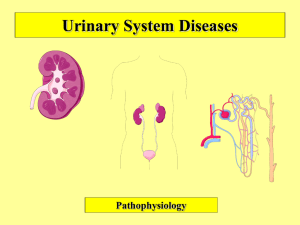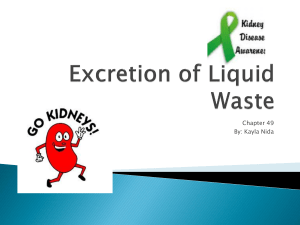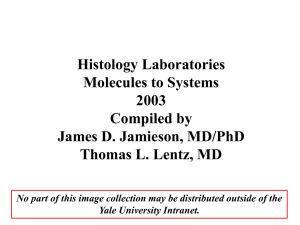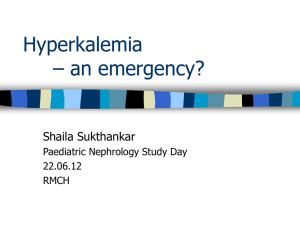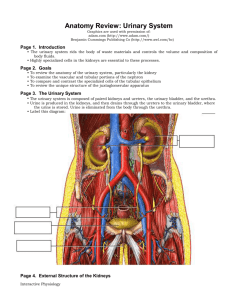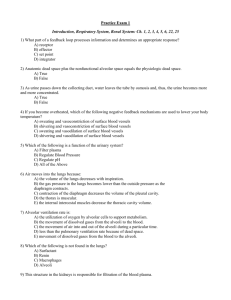Chapter 36
advertisement
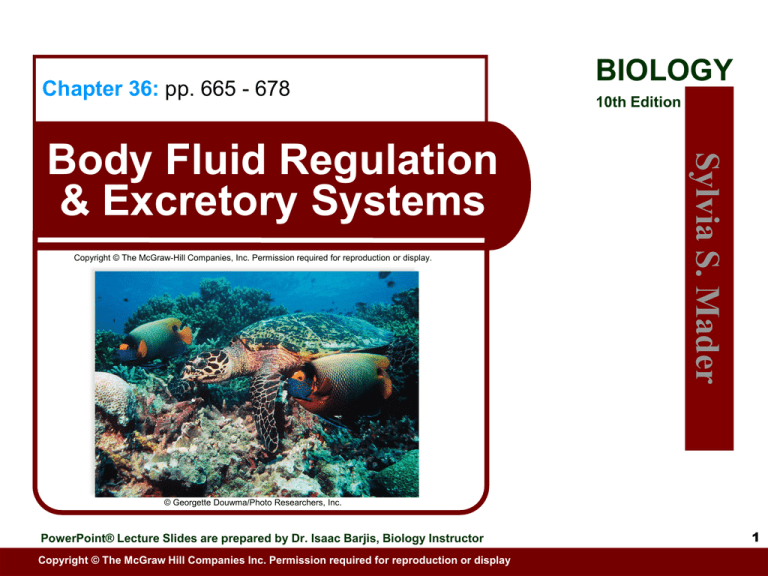
Chapter 36: pp. 665 - 678 Copyright © The McGraw-Hill Companies, Inc. Permission required for reproduction or display. 10th Edition Sylvia S. Mader Body Fluid Regulation & Excretory Systems BIOLOGY © Georgette Douwma/Photo Researchers, Inc. PowerPoint® Lecture Slides are prepared by Dr. Isaac Barjis, Biology Instructor Copyright © The McGraw Hill Companies Inc. Permission required for reproduction or display 1 Outline Body Fluid Regulation Aquatic Animals Marine Bony Fish Freshwater Bony Fish Terrestrial Animals Nitrogenous Waste Products Organs of Excretion Urinary System in Humans Kidneys Urine 2 Nitrogenous Waste Products Catabolism of amino acids and nucleic acids results in ammonia High solubility permits it to be excreted directly by many aquatic animals Terrestrial animals must convert ammonia to urea or uric acid Urea causes loss of much water per unit of nitrogen Mammals and amphibians Must drink lots of water Uric acid requires much less water per unit of nitrogen excreted Reptiles, birds, and arthropods Require much less water than mammals and amphibians Allows invasion of drier habitats far from standing water 3 Nitrogenous Wastes Copyright © The McGraw-Hill Companies, Inc. Permission required for reproduction or display. proteins amino acids NH2 most fishes and other aquatic animals adult amphibians, sharks, and mammals Insects, birds, and reptiles ammonia urea uric acid O H N O H H2N C HN NH2 C H C N C O C H O C N N H H water needed to excrete energy needed to produce 4 Organs of Excretion in Invertebrates Most animals have tubular excretory organs Regulate the water-salt balance of the body Excrete metabolic wastes into the environment Flame Cells in Planarians Nephridia in Earthworms Malpighian Tubules in Insects 5 Excretory Organs in Animals Copyright © The McGraw-Hill Companies, Inc. Permission required for reproduction or display. flame cell excretory tubule fluid filtering into flame cell flame cell nucleus cilia excretory pore excretory tubule a. Flame-cell excretory system in planarians capillary network tubule bladder septum entrance of nephridiostome pore b. Earthworm nephridium 6 Body Fluid Regulation An excretory system regulate body fluid concentrations Dependent upon concentration of mineral ions such as sodium and potassium Water can enter the body through: Drink Food Metabolism 7 Body Fluid Regulation Water tends to move into the region with the lowest water concentration A marine environment High in dissolved salts Tends to promote the osmotic loss of water, and The gain of ions by drinking water Marine invertebrates nearly isotonic to seawater Blood of cartilaginous fishes contains enough urea to match the tonicity of sea water Fresh water environment Tends to promote a gain of water by osmosis, and A loss of ions as excess water is excreted 8 Aquatic Animals Bony Fishes Body fluids of bony fishes with only moderate amount of salt Marine bony fishes Body fluids hypotonic to sea water Passively lose water through gills Must constantly drink seawater to compensate Excess salt ions actively transported back into seawater through the gills Freshwater bony fishes have opposite problem Body fluids hypertonic to fresh water Passively gain water through gills Eliminate excess water through copious hypotonic urine 9 Body Fluid Regulation in Bony Fishes Copyright © The McGraw-Hill Companies, Inc. Permission required for reproduction or display. passive loss of water through gills drinks seawater salts actively excreted by gills scanty amount of isotonic urine contains some salts a. Marine bony fish passive gain of water through gills does not drink salts actively taken up by gills b. Freshwater bony fish large amounts of hypotonic urine contain few salts 10 Osmoregulation in a Shark Copyright © The McGraw-Hill Companies, Inc. Permission required for reproduction or display. © Digital Vision Ltd 11 Terrestrial Animals Terrestrial animals lose water through excretion and respiration Must drink water to make up for loss Some reduce excretory loss by excreting nitrogen as relatively insoluble uric acid Certain animals also have a highly convoluted nasal passage with a mucous membrane surface 12 Adaptations of a Kangaroo Rat to a Dry Environment Copyright © The McGraw-Hill Companies, Inc. Permission required for reproduction or display. Exhaled air is cooled and dried in long convoluted air passages. Animal fur prevents evaporative loss of water at skin. Urine is the most hypertonic known among animals. Fecal pellets are dry. Oxidation of food results in metabolic water. © Bob Calhoun/Bruce Coleman, Inc. 13 Adaptations of Marine Birds to a High Salt Environment Copyright © The McGraw-Hill Companies, Inc. Permission required for reproduction or display. salt solution exits here salt solution runs down beak here © Eric Hosking/Photo Researchers, Inc. 14 Urinary System in Humans Human kidneys Located on either side of vertebral column, just below the diaphragm Each connected to a ureter Conducts urine from the kidney to the urinary bladder Urine voided through urethra Tube between bladder and exit 15 The Human Urinary System Copyright © The McGraw-Hill Companies, Inc. Permission required for reproduction or display. renal artery 1. Kidneys produce urine. renal vein aorta inferior vena cava 2. Ureters transport urine. 3. Urinary bladder stores urine. 4. Urethra passes urine to outside. a. b. © James Cavallini/Photo Researchers, Inc. 16 Kidneys Renal cortex Outer region Granular appearance Renal medulla Cone-shaped renal pyramids Renal pelvis Hollow-chambered innermost part of the kidney 17 Animation Please note that due to differing operating systems, some animations will not appear until the presentation is viewed in Presentation Mode (Slide Show view). You may see blank slides in the “Normal” or “Slide Sorter” views. All animations will appear after viewing in Presentation Mode and playing each animation. Most animations will require the latest version of the Flash Player, which is available at http://get.adobe.com/flashplayer. Macroscopic & Microscopic Anatomy of the Kidney Copyright © The McGraw-Hill Companies, Inc. Permission required for reproduction or display. nephrons renal pelvis renal cortex renal medulla collecting duct ureter renal artery and vein a. Gross anatomy renal pyramid in renal medulla renal pelvis b. Two nephrons 19 Nephrons Each kidney composed of many tubular nephrons Each nephron composed of several parts Glomerular capsule Glomerulus Proximal convoluted tubule Loop of the nephron Distal convoluted tube Collecting duct 20 Nephron Anatomy Copyright © The McGraw-Hill Companies, Inc. Permission required for reproduction or display. peritubular capillary Renal Cortex proximal convoluted tubule glomerular capsule (Bowman's capsule) distal convoluted tubule afferent arteriole efferent arteriole glomerulus efferent arteriole glomerulus b. Surface view of glomerulus and its blood supply distal convoluted tubule afferent arteriole microvilli proximal convoluted tubule venule c. Cross sections of proximal and distal convoluted tubules renal artery renal vein peritubular capillary network 20 µm ascending limb descending limb collecting duct Loop of the nephron (loop of Henle) descending limb capillaries ascending limb collecting duct Renal Medulla a. Anephron and its blood supply d. Cross sections of a loop of nephron limbs and collecting duct. (The other cross sections are those of capillaries.) 10 µm b: © R.G. Kessel and R H. Kardon, Tissues and Organs: A Text-Atlas of Scanning Electron Microscopy. W. H. Freeman & Co., San Francisco 1979; c, d: Journal of Ultrastructure Research by Maunsbach, Arvid B. Copyright 1966 by Elsevier Science & Technology Journals. Reproduced with permission of Elsevier Science & Technology Journals in the format Textbook via Copyright Clearance Center 21 Proximal Convoluted Tubule Copyright © The McGraw-Hill Companies, Inc. Permission required for reproduction or display. peritubular capillary proximal convoluted tubule cell lumen microvilli mitochondrion nucleus a. 500× b. a: © Joseph F. Gennaro, Jr./Photo Researchers, Inc. 22 Urine Formation Urine production requires three distinct processes: Glomerular filtration in glomerular capsule Tubular reabsorption at the proximal convoluted tubule Tubular secretion at the distal convoluted tubule 23 Processes in Urine Formation Copyright © The McGraw-Hill Companies, Inc. Permission required for reproduction or display. glomerular capsule H2O Glomerular Filtration Water, salts, nutrient molecules, and waste molecules move from the glomerulus to the inside of the glomerular capsule. These small molecules are called the glomerular filtrate. urea glucose amino acids uric acid salts proximal convoluted tubule Tubular Reabsorption Nutrient and salt molecules are actively reabsorbed from the convoluted tubules into the peritubular capillary network, and water flows passively. glomerulus efferent arteriole Tubular Secretion Certain molecules (e.g., H+ and penicillin) are actively secreted from the peritubular capillary network into the convoluted tubules. afferent arteriole distal convoluted tubule renal artery renal vein venule collecting duct peritubular capillary network loop of the nephron H2O urea uric acid salts NH4+ creatinine 24 Animation Please note that due to differing operating systems, some animations will not appear until the presentation is viewed in Presentation Mode (Slide Show view). You may see blank slides in the “Normal” or “Slide Sorter” views. All animations will appear after viewing in Presentation Mode and playing each animation. Most animations will require the latest version of the Flash Player, which is available at http://get.adobe.com/flashplayer. Reabsorption of Salt and Water Copyright © The McGraw-Hill Companies, Inc. Permission required for reproduction or display. C1- Na+ Increasing solute concentration in renal medulla H2O Renal cortex Outer medulla ascending limb Na+ H2O H2O C1- descending limb Urea H2O H2O Inner medulla loop of the nephron collecting duct 26 Urine Formation and Homeostasis Excretion of hypertonic urine Dependent upon the reabsorption of water Absorbed from Loop of the nephron, and The collecting duct Osmotic gradient within the renal medulla causes water to leave the descending limb along its entire length Antidiuretic hormone (ADH) Plays a role in water reabsorption Released by the posterior lobe of the pituitary 27 The Renin-Angiotensin-Aldosterone System Copyright © The McGraw-Hill Companies, Inc. Permission required for reproduction or display. liver kidneys adrenal cortex secrete renin blood vessel stimulates secretes secretes speeds angiotensin I angiotensin II angiotensinogen aldosterone 28 Maintenance of pH and Osmolality More than 99% of sodium filtered at glomerulus is returned to blood at the distal convoluted tubule Reabsorption of sodium regulated by hormones Aldosterone Renin Atrial Natriuretic Hormone (ANH) pH adjusted by either The reabsorption of the bicarbonate ions, or The secretion of hydrogen ions 29 Review Body Fluid Regulation Aquatic Animals Marine Bony Fish Freshwater Bony Fish Terrestrial Animals Nitrogenous Waste Products Organs of Excretion Urinary System in Humans Kidneys Urine 30 Chapter 36: pp. 665 - 678 Copyright © The McGraw-Hill Companies, Inc. Permission required for reproduction or display. 10th Edition Sylvia S. Mader Body Fluid Regulation & Excretory Systems BIOLOGY © Georgette Douwma/Photo Researchers, Inc. PowerPoint® Lecture Slides are prepared by Dr. Isaac Barjis, Biology Instructor Copyright © The McGraw Hill Companies Inc. Permission required for reproduction or display 31

